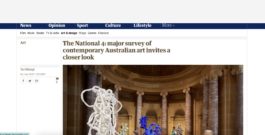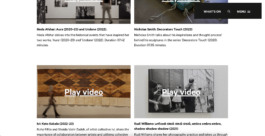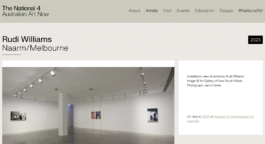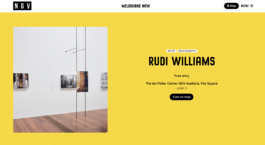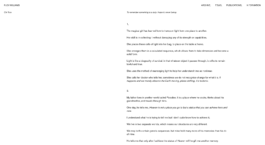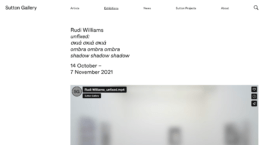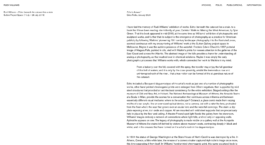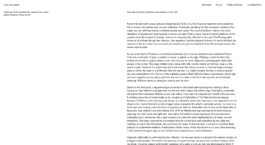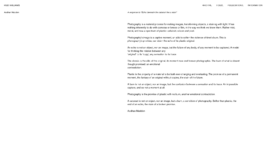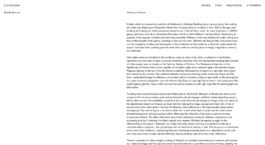Aphrodite and Echo: blindness and shadows in the cave
Michelle Mountain
A response to: Echo: beneath the cataract lies a stain, Sutton Projects, Fitzroy 2018
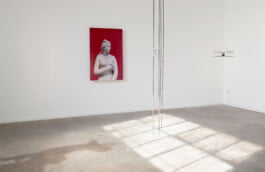
Ancient Greek myth curses verbose Oreiad-nymph, Echo, to a life of spoken repetition and condemns her to a lover who adores only his own reflection. Eventually retreating into the mountain conifers of her origin, we can still hear echoes in hillside forests and caves. The caves that Echo hides in, the echo chambers of sound reverberating back, however, are also Plato’s caves. Caverns where shadows of the outside world illuminated by firelight trick us into believing the reflection is the real. The photographic device is all of these things: the reflection, the repetition, and the shadow. In front of it we’re all blind, the cataract of the lens obscures our vision and diverts our gaze, but beneath it lies the incongruencies, the marks and the stain.
As you enter Sutton Projects, a converted warehouse with a history etched in once industrial Fitzroy, there lies a red stain. A spot, a splatter, a smear, a splash, a smudge. Perhaps a mark of where the bodies are buried or a place where a river ran but runs no more. Adjacent, a photographic Aphrodite weeps in the corner. This large reddish stain, along with other smaller stains on the floor, map out the viewer’s path. Stand on the right mark and it will reveal the hidden secrets in reflected daguerreotype glass or mimic the stain of a birthmark. Like the secrets of a hidden temple, the key to unlocking each clue lies embedded in the memory of the exhibition space. Rudi Williams draws connections, she brings moments together across place and time, the work is made to feel both site-specific and timelessly enduring. Williams draws us along her journey step by step.
Drawn to the first point, a daguerreotype mounted on tall metal rods reaching from ceiling to floor, moving so that reflections divulge form we are met with a Nape, the artist’s nape. A tenderly vulnerable self-portrait that illustrates Williams is not only willing to lay bare her subjects but herself in the process. A winding seduction of necks leads us to a sculpture of Aphrodite in The National Archaeological Museum of Athens, a thin slicing crack along her collarbone where her head was once departed from her chest, to her neck reflected in a silver/copper plate alongside the artist’s, and lastly across the room to a bird’s eye view looking down the back of polystyrene ‘Adonis’. Aphrodite, also known as the Aphrodite of Syracuse, was crafted circa 2nd century A.D. of Pirian Marble and was restored by Antonio Canova, repairing her head, neck and right arm. Just below Aphrodite’s remaining fissure of unceremonious beheading sits a red bruise, like a ruby necklace on a thin link chain highlighted by the deep red wall behind her. This stain, mirrored by the reddish blemish on the floor and underlined by her right arm reaching across to her left breast, sits just above her heart. A stained heart, a wound or tarnished flesh, perhaps an inadvertent emblem of Aphrodite’s fabled vanity, which has become our own. Time travelling to the present Instagram age we are all Narcissus, trapped by our own reflections.
Opposite, Aphrodite is confronted by her reflection, her bruised chest is echoed in the stained surface of a daguerreotype plate. The artist in the process of experimenting, has polished the silver surface a little too deep, revealing copper underneath, exposing not a stain or a bruise but raw photographic flesh. A stain reflected back in a stain. In an adjacent corner a pigment print on glass mimics the pole mounted daguerreotypes at the centre of the room. The image depicts an architectural glass screen at the Museum of Old and New Art in Hobart, which simultaneously reflects light from the artwork in front and silhouettes the shapes of gallery visitors behind. Hopping across continents, the next photograph was taken at Ansaldo Teatro alla Scala in Milan, a workshop where the props and sets are made for La Scala theatre productions. In all their glory, we look down on several white marble columns and a male form. Seemingly, an equally handsome companion to Aphrodite, perhaps Adonis before his death, beneath his feet a white powdery floor alludes to his hollow secret, that these props are nothing more than polystyrene. A reflection of a copy, where shadows and facsimile collide with reality. Towards the end of the gallery, Williams constructs a second illusion. Cataract an acrylic sculpture that both obscures our view of the exhibition and replicates it. Through optical illusion, Aphrodite is mirrored a second time, on the right the original image intersected by multiple thin slivers of acrylic and on the left each thin acrylic sliver mirroring back to create a distorted lesser double. A previous acrylic installation by Williams was titled Lethe (λήθη) after the river; instead this work drawing on the multiple meanings of ‘cataract’, is a waterfall falling off its river edges, simultaneously revealing and concealing the drop towards oblivion. A light behind the work replicates the changing daylight that streams in through a grid of windows into the space, sunlight moving itself across the work at various stages of the day.
In the far alcove of the Project space sits the final photograph, Oxidise, Head of Goddess predicted to be Aphrodite, taken at The Acropolis Museum. This second mysterious depiction of Aphrodite dated 2nd c. A.D. is believed to be an imitation in marble of a chryselephantine statue of the 4th c. B.C. All that remains of this sculpture is her face and fragmented hornlike headdress, which sit in the museum room across from stools where the ghostly imprints of visitors hang, the shadowy touch of their backs leaving stains on the wall. Oxidization of the statue’s bronze eyelashes flow from the eyes like a tear-stained face. A mourning Aphrodite, perhaps tears dripping back into the sea form from which she came. Like Echo, she is an enduring witness to our plights, to our mistakes, to the stains we leave behind, and to our imprisonment in the black box where shadows deceive the real. Echo: beneath the cataract lies a stain captures the complex and wounded heart of photography. It rubs deeper, beyond the surface of facsimile, to raw photographic flesh where the reflection falters, the light stains and pigment is revealed. It manifests an Aphrodite-Echo, instantaneously haughty, vain and mournful, a reflection of us and a silent witness to our blindness. Pulling works from cross continent museums and theatres, this exhibition draws back the curtain of the camera. Plato’s cave, Echo’s cave, the cataract and the stain.
Michelle Mountain is a writer and curator based in Melbourne, Australia
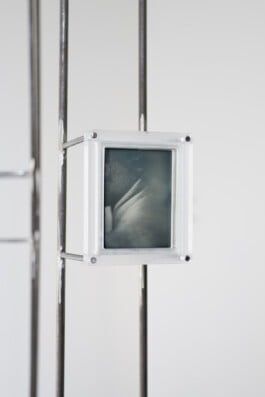
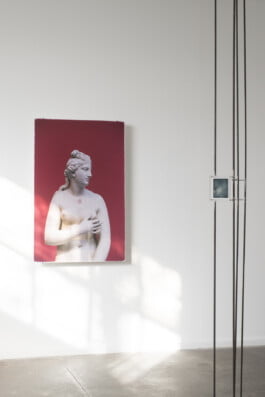
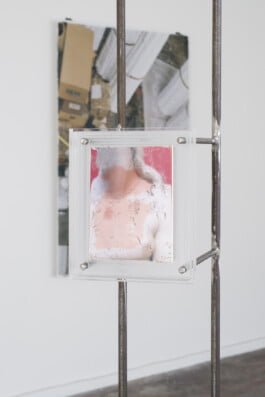
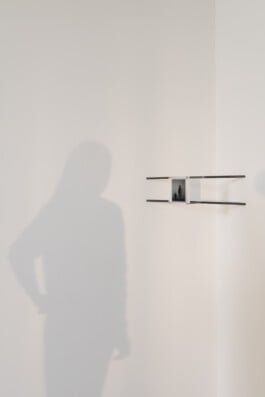
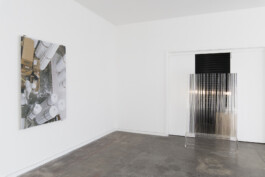
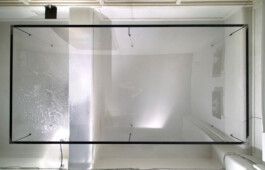

Aphrodite and Echo: blindness and shadows in the cave
Michelle Mountain
A response to: Echo: beneath the cataract lies a stain, Sutton Projects, Fitzroy 2018

Ancient Greek myth curses verbose Oreiad-nymph, Echo, to a life of spoken repetition and condemns her to a lover who adores only his own reflection. Eventually retreating into the mountain conifers of her origin, we can still hear echoes in hillside forests and caves. The caves that Echo hides in, the echo chambers of sound reverberating back, however, are also Plato’s caves. Caverns where shadows of the outside world illuminated by firelight trick us into believing the reflection is the real. The photographic device is all of these things: the reflection, the repetition, and the shadow. In front of it we’re all blind, the cataract of the lens obscures our vision and diverts our gaze, but beneath it lies the incongruencies, the marks and the stain.
As you enter Sutton Projects, a converted warehouse with a history etched in once industrial Fitzroy, there lies a red stain. A spot, a splatter, a smear, a splash, a smudge. Perhaps a mark of where the bodies are buried or a place where a river ran but runs no more. Adjacent, a photographic Aphrodite weeps in the corner. This large reddish stain, along with other smaller stains on the floor, map out the viewer’s path. Stand on the right mark and it will reveal the hidden secrets in reflected daguerreotype glass or mimic the stain of a birthmark. Like the secrets of a hidden temple, the key to unlocking each clue lies embedded in the memory of the exhibition space. Rudi Williams draws connections, she brings moments together across place and time, the work is made to feel both site-specific and timelessly enduring. Williams draws us along her journey step by step.
Drawn to the first point, a daguerreotype mounted on tall metal rods reaching from ceiling to floor, moving so that reflections divulge form we are met with a Nape, the artist’s nape. A tenderly vulnerable self-portrait that illustrates Williams is not only willing to lay bare her subjects but herself in the process. A winding seduction of necks leads us to a sculpture of Aphrodite in The National Archaeological Museum of Athens, a thin slicing crack along her collarbone where her head was once departed from her chest, to her neck reflected in a silver/copper plate alongside the artist’s, and lastly across the room to a bird’s eye view looking down the back of polystyrene ‘Adonis’. Aphrodite, also known as the Aphrodite of Syracuse, was crafted circa 2nd century A.D. of Pirian Marble and was restored by Antonio Canova, repairing her head, neck and right arm. Just below Aphrodite’s remaining fissure of unceremonious beheading sits a red bruise, like a ruby necklace on a thin link chain highlighted by the deep red wall behind her. This stain, mirrored by the reddish blemish on the floor and underlined by her right arm reaching across to her left breast, sits just above her heart. A stained heart, a wound or tarnished flesh, perhaps an inadvertent emblem of Aphrodite’s fabled vanity, which has become our own. Time travelling to the present Instagram age we are all Narcissus, trapped by our own reflections.
Opposite, Aphrodite is confronted by her reflection, her bruised chest is echoed in the stained surface of a daguerreotype plate. The artist in the process of experimenting, has polished the silver surface a little too deep, revealing copper underneath, exposing not a stain or a bruise but raw photographic flesh. A stain reflected back in a stain. In an adjacent corner a pigment print on glass mimics the pole mounted daguerreotypes at the centre of the room. The image depicts an architectural glass screen at the Museum of Old and New Art in Hobart, which simultaneously reflects light from the artwork in front and silhouettes the shapes of gallery visitors behind. Hopping across continents, the next photograph was taken at Ansaldo Teatro alla Scala in Milan, a workshop where the props and sets are made for La Scala theatre productions. In all their glory, we look down on several white marble columns and a male form. Seemingly, an equally handsome companion to Aphrodite, perhaps Adonis before his death, beneath his feet a white powdery floor alludes to his hollow secret, that these props are nothing more than polystyrene. A reflection of a copy, where shadows and facsimile collide with reality. Towards the end of the gallery, Williams constructs a second illusion. Cataract an acrylic sculpture that both obscures our view of the exhibition and replicates it. Through optical illusion, Aphrodite is mirrored a second time, on the right the original image intersected by multiple thin slivers of acrylic and on the left each thin acrylic sliver mirroring back to create a distorted lesser double. A previous acrylic installation by Williams was titled Lethe (λήθη) after the river; instead this work drawing on the multiple meanings of ‘cataract’, is a waterfall falling off its river edges, simultaneously revealing and concealing the drop towards oblivion. A light behind the work replicates the changing daylight that streams in through a grid of windows into the space, sunlight moving itself across the work at various stages of the day.
In the far alcove of the Project space sits the final photograph, Oxidise, Head of Goddess predicted to be Aphrodite, taken at The Acropolis Museum. This second mysterious depiction of Aphrodite dated 2nd c. A.D. is believed to be an imitation in marble of a chryselephantine statue of the 4th c. B.C. All that remains of this sculpture is her face and fragmented hornlike headdress, which sit in the museum room across from stools where the ghostly imprints of visitors hang, the shadowy touch of their backs leaving stains on the wall. Oxidization of the statue’s bronze eyelashes flow from the eyes like a tear-stained face. A mourning Aphrodite, perhaps tears dripping back into the sea form from which she came. Like Echo, she is an enduring witness to our plights, to our mistakes, to the stains we leave behind, and to our imprisonment in the black box where shadows deceive the real. Echo: beneath the cataract lies a stain captures the complex and wounded heart of photography. It rubs deeper, beyond the surface of facsimile, to raw photographic flesh where the reflection falters, the light stains and pigment is revealed. It manifests an Aphrodite-Echo, instantaneously haughty, vain and mournful, a reflection of us and a silent witness to our blindness. Pulling works from cross continent museums and theatres, this exhibition draws back the curtain of the camera. Plato’s cave, Echo’s cave, the cataract and the stain.
Michelle Mountain is a writer and curator based in Melbourne, Australia







